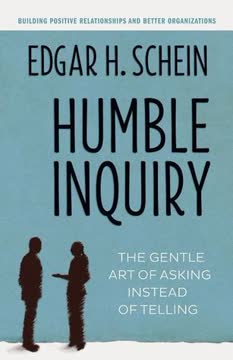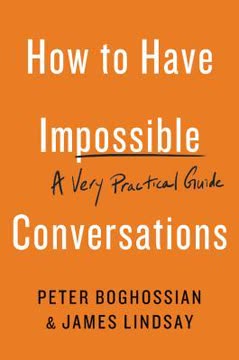Key Takeaways
1. Embrace the fundamentals of good conversations
Nobody likes to be lectured.
Establish partnership. Treat your conversation partner as a collaborator, not an adversary. Focus on understanding their reasoning rather than winning an argument. This shift in mindset creates a psychologically safe environment for open dialogue.
Listen actively. Pay attention to what your partner is saying, ask clarifying questions, and acknowledge their perspective. Avoid interrupting or formulating rebuttals while they speak. Instead, strive to truly comprehend their point of view.
Build rapport. Find common ground and shared interests to create a foundation of trust. Use minimal encouragers like "I see" or "Go on" to show you're engaged. Mirroring your partner's language and body language can also help foster connection.
2. Ask questions and focus on epistemology
How could that belief be incorrect?
Probe deeper. Instead of challenging beliefs directly, ask open-ended questions about how your partner arrived at their conclusions. This shifts the focus to their reasoning process rather than the belief itself.
Explore epistemology. Investigate how your conversation partner knows what they claim to know. This can reveal potential flaws in their reasoning or highlight areas where they may be relying on incomplete information.
Use calibrated questions. Frame inquiries with "how" or "what" to encourage more detailed responses. For example, "What led you to that conclusion?" or "How might someone with a different perspective view this issue?"
3. Let friends be wrong and build golden bridges
It's better to be refuted than to refute.
Prioritize relationships. Accept that disagreements are normal and don't need to threaten friendships. Allow your friends to hold differing views without feeling compelled to correct them constantly.
Create exit ramps. Provide face-saving ways for your partner to change their mind or back down from a position. Use phrases like "I can see why you might think that" or "That's an interesting perspective I hadn't considered."
Acknowledge good intentions. Recognize that most people are trying to do what they believe is right, even if you disagree with their conclusions. This helps maintain a respectful dialogue.
4. Reframe conversations and change your mind when warranted
I just realized my belief might be wrong. I've changed my mind.
Shift perspectives. When conversations become stuck, try reframing the issue from a different angle. This can help both parties see the topic in a new light and move past impasses.
Model intellectual humility. Be willing to admit when you're wrong or when new information changes your perspective. This demonstrates that changing one's mind is a strength, not a weakness.
Use scales for nuance. Introduce numerical scales (e.g., 1-10) to gauge confidence levels in beliefs. This can reveal areas of uncertainty and create openings for further discussion.
5. Use disconfirmation to instill doubt
Under what conditions could [insert belief] be wrong?
Challenge assumptions. Ask your partner to consider what evidence or circumstances would cause them to question their belief. This encourages critical thinking about the foundations of their views.
Explore hypotheticals. Present scenarios that might contradict their position, encouraging them to think through the implications. This can reveal inconsistencies or areas of uncertainty in their reasoning.
Avoid facts and arguments. Resist the urge to present counterevidence, as this often leads to defensiveness. Instead, focus on helping your partner generate their own reasons for doubt.
6. Master the art of moral reframing
Nobody cares how much you know until they know how much you care.
Understand moral foundations. Recognize that people have different moral intuitions based on factors like care, fairness, loyalty, authority, sanctity, and liberty. These shape their worldviews and political leanings.
Speak their moral language. When discussing issues, frame your arguments in terms that resonate with your partner's moral foundations. This makes your points more persuasive and relatable.
Find common ground. Identify shared values and use them as a bridge to discuss more contentious issues. This creates a sense of moral alignment and reduces defensiveness.
7. Navigate difficult conversations with ideologues
Moral conversations are extremely difficult to navigate because moral beliefs are closely tied to issues of personal identity and community.
Acknowledge intentions. Recognize that even those with extreme views often believe they're acting for the greater good. This creates an opening for more productive dialogue.
Focus on underlying values. Shift the conversation from specific beliefs to the core values that inform them. This can reveal common ground and areas for potential agreement.
Use identity questions. Ask how holding certain beliefs relates to being a good person. This can help separate moral identity from specific positions and create space for reconsideration.
Last updated:
FAQ
What's How to Have Impossible Conversations about?
- Effective Communication Focus: The book provides strategies for engaging in conversations with people who hold radically different beliefs, especially in a polarized society.
- Addressing Polarization: It tackles the challenges of conversing across divides in politics, religion, and values, aiming to reduce fear and hostility.
- Practical Techniques: Offers practical techniques and strategies to engage in productive dialogue, even when conversations seem impossible.
Why should I read How to Have Impossible Conversations?
- Improve Relationships: It equips you with skills to navigate difficult conversations without damaging connections.
- Build Understanding: Encourages empathy and understanding, allowing engagement with others' beliefs without confrontation.
- Combat Polarization: Provides tools to bridge gaps and foster civil discourse, relevant for anyone seeking meaningful engagement.
What are the key takeaways of How to Have Impossible Conversations?
- Seven Fundamentals: Outlines seven fundamentals for good conversations, including setting clear goals and listening actively.
- Levels of Skills: Techniques are categorized into beginner, intermediate, advanced, and expert levels for progressive learning.
- Focus on Epistemology: Emphasizes understanding how people know what they believe, rather than just challenging their beliefs.
What are the Seven Fundamentals of Good Conversations in How to Have Impossible Conversations?
- Goals: Identify your purpose for the conversation to guide your approach and expectations.
- Partnerships: Treat the other person as a partner rather than an adversary to foster collaboration.
- Rapport: Build a connection to create a comfortable environment for open dialogue.
- Listen: Prioritize listening over speaking to understand the other person's perspective.
- Walk Away: Know when to end the conversation if it becomes unproductive or heated.
How can I start changing minds according to How to Have Impossible Conversations?
- Modeling Behavior: Demonstrate patience and openness to change, setting an example for others.
- Ask Questions: Use specific questions to guide the conversation and encourage reflection.
- Acknowledge Extremists: Recognize extreme behaviors on your side to build trust and common ground.
What is the significance of focusing on epistemology in How to Have Impossible Conversations?
- Understanding Beliefs: Helps you understand how someone arrived at their beliefs, rather than just what those beliefs are.
- Encouraging Doubt: Exploring the reasoning behind beliefs can instill doubt and encourage open-mindedness.
- Avoiding Defensiveness: Reduces defensiveness, as people are more willing to discuss their reasoning than defend conclusions.
How does How to Have Impossible Conversations suggest dealing with anger during conversations?
- Recognize Triggers: Be aware of your own and your partner's anger triggers to manage emotions effectively.
- Pause and Reflect: Take a moment to pause and reflect before responding to avoid escalation.
- Listen Actively: Focus on listening to your partner's concerns to de-escalate tension and foster understanding.
What is the Synthesis method in How to Have Impossible Conversations?
- Iterative Process: Involves presenting an idea, inviting counterarguments, and refining beliefs through dialogue.
- Focus on Disconfirmation: Encourages seeking disconfirmation of beliefs to reveal blind spots and lead to nuanced positions.
- Collaborative Engagement: Promotes a collaborative atmosphere where both parties explore and refine ideas together.
What is Altercasting in How to Have Impossible Conversations?
- Role Assignment: Assigns a role to encourage different perspectives, fostering more open dialogue.
- Influence Behavior: Casting someone in a positive light can create a sense of obligation to live up to that role.
- Ethical Considerations: Caution is advised to use it ethically, fostering understanding rather than control.
How does moral reframing work in How to Have Impossible Conversations?
- Recasting Ideas: Presents arguments in terms that resonate with the other person's moral values.
- Bridging Divides: Aligns discussions with shared moral foundations to find common ground.
- Effective Communication: Understanding and speaking the "moral dialect" enhances dialogue effectiveness.
What is the Unread Library Effect mentioned in How to Have Impossible Conversations?
- Knowledge Gaps: Refers to holding strong beliefs about topics not fully explored or understood.
- Encouraging Exploration: Recognizing this effect can open individuals to questioning beliefs and seeking new information.
- Promoting Humility: Acknowledging knowledge limitations fosters a humble approach, making one more receptive to differing viewpoints.
How do I engage with ideologues according to How to Have Impossible Conversations?
- Acknowledge Good Intentions: Affirming the ideologue's identity as a good person can lower defenses.
- Shift to Values: Engage in conversations about underlying values rather than directly challenging beliefs.
- Induce Doubt: Use targeted questions to help them reflect on their moral conclusions, leading to reevaluation over time.
Review Summary
How to Have Impossible Conversations receives mixed reviews. Many readers find it practical and insightful, offering valuable techniques for engaging in difficult discussions. The book emphasizes understanding others' perspectives, building rapport, and focusing on epistemology rather than conclusions. Some critics argue it lacks depth, promotes manipulation, and reflects the authors' biases. The book's structure and writing style are praised by some but criticized by others. Overall, readers appreciate its emphasis on civility and empathy in conversations, though its effectiveness in real-world applications is debated.
Similar Books










Download PDF
Download EPUB
.epub digital book format is ideal for reading ebooks on phones, tablets, and e-readers.





